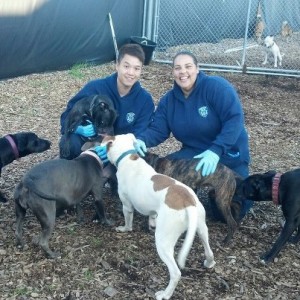 Oakland Animal Control Officers Jackie and Nicole running a play group!
Oakland Animal Control Officers Jackie and Nicole running a play group!
When dog handler and trainer Aimee Sadler brought her training program to Oakland Animal Services (OAS) earlier this month, she brought with her some old ideas—that dogs are social animals and that they thrive in packs—into which she’s breathed new life, saying that play groups, even in shelter settings, yield amazingly positive benefits for the animals.
Sadler, a nationally recognized expert on shelter dogs, is formerly of Longmont Humane Society in Colorado and currently with Southampton Animal Rescue Foundation in New York. She came to OAS and the Bay Area with her presentation “Playing for Life . . . a Training and Behavior Program for Sheltered Dogs Featuring Play Groups” and the conviction that animal groups in the United States can do better by its shelter dogs . . . much better. The training wowed attendees, had dogs barking for more, and introduced OAS to a practice that could potentially change a lot about shelter procedure and life for the dogs passing through it.
A grant from Animal Farm Foundation, in response to Oakland Animal Services’ proposal, brought Sadler to Oakland for two days, December 12 and 13. OAS opened the training to all interested shelters in the Bay Area, ultimately putting together an audience of 50 people representing 6 shelters and groups. At the Pet Food Express headquarters’ classroom, Sadler used her PowerPoint and video presentation to show OAS staff, mentors, and dog crew—as well as staff and volunteers from across the Bay Area—proof of the enrichment, training, and behavior programs that Sadler has been implementing. Her programs build on play groups as a foundation for happier, healthier shelter dogs and have led to “canine live release rates” exceeding 95 percent and an encouraging decrease in euthanasia rates.
After the three-hour presentation, the rest of the two-day training was at OAS. There, Sadler showed her work in action, engaging OAS dogs—most of whom had never been with more than one dog at the shelter—in play groups of half a dozen or more. In the groups, the dogs romped, and ran, and rolled to their hearts’ content, showing volunteers and shelter staff that letting dogs be dogs has wildly healthful benefits and that, for the most part, the dogs can figure it out and play exceedingly well together. For their part, the attending humans learned to evaluate play styles and other behavior, match compatible personalities, and, primarily, remain in the background of the whirling play.
Since Sadler and her team left, OAS staff and volunteers have continued working the groups, experimenting with ways in which to work them into the regular schedule of the shelter to the benefit of all. Dog Crew even took a group of dogs out on the lawn to play during open shelter hours—what a better way to show off our dogs than in a kennel!
“Working with Aimee Sadler was such a fantastic opportunity,” said OAS Director Megan Webb of the two-day session. “What Aimee has taught us really should improve the quality of life for all of the dogs as well as increase their adoptability.” Webb’s words have been echoed again and again by staff and volunteers; they are noticing a decrease in overall kennel stress, spent dogs sleeping after play sessions, and the sheer joy of the dogs at play.
There is nothing new under the sun, it is said. Aimee Sadler’s play-group idea, as she will be the first to point out, is a take on age-old knowledge about our canine companions, but it is an idea whose time has come, again, and one that will certainly push shelter standards and result in positive upward movement for shelter animal health and placement. And that is always a good idea.